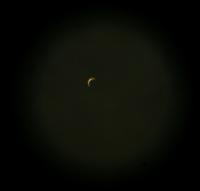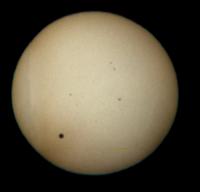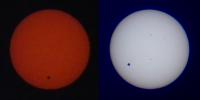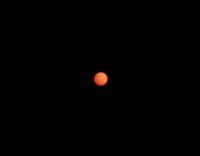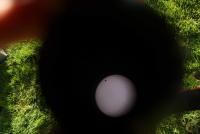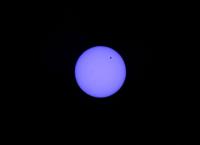Printable Version of Topic
Click here to view this topic in its original format
Unmanned Spaceflight.com _ Chit Chat _ Transit of Venus
Posted by: PDP8E May 21 2012, 02:42 AM
Q: Will the transit of Venus in a few weeks, be visible at Mars?
Could Oppy (or orbiters) resolve it ???
Posted by: nprev May 21 2012, 03:50 AM
No. Mars would have to be both in precise opposition with the Earth (which it isn't) and at a point in its orbit that was precisely coplanar with our own. In fact, you'd probably see a transit of BOTH Earth & Venus from Mars given those circumstances.
I'm sure it happens, but the interval between occurrences probably has to be measured in geological time.
Posted by: brellis May 21 2012, 05:39 AM
That brings up a [probably silly] question: would anything be visible to MESSENGER if it pointed towards Venus during transit?
Posted by: djellison May 21 2012, 06:11 AM
Why would it? Venus doesn't care that the Earth's in opposition.
Posted by: Astro0 May 21 2012, 09:50 AM
ADMIN NOTE: Some OT mentions of the transit and its observation moved here (as above).
Posted by: charborob May 21 2012, 02:28 PM
According to http://en.wikipedia.org/wiki/Transit_of_Earth_from_Mars, the last transit of Earth from Mars was on May 11, 1984, and the next will be on November 10, 2084.
According to http://en.wikipedia.org/wiki/Transit_of_Venus_from_Mars, the last transit of Venus from Mars was on August 21, 1998, and the next will be on August 19, 2030. Transits of Venus seen from Mars seem to be more frequent than those seen from Earth. It is because the planes of the orbits of the two planets are closer than the planes of the orbits of Earth and Venus.
The next simultaneous Earth-Venus transit seen from Mars will be in the year 571,471.
Posted by: Stu May 21 2012, 02:32 PM
So about the time ExoMars will get there. Great timing! B)
Posted by: stevesliva May 21 2012, 03:40 PM
That'll make for some great chain emails among the residents of Mars.
Posted by: rogelio May 21 2012, 04:24 PM
"The next simultaneous Earth-Venus transit seen from Mars will be in the year 571,471."
I assume that a simultaneous Mercury-Venus transit as seen from Earth is impossible because of the difference in orbital planes?
Posted by: brellis May 21 2012, 05:25 PM
My silly question rephrased: at this point in its mission would MESSENGER ever be capable of imaging any of the other planets?
Posted by: djellison May 21 2012, 08:47 PM
It already has - http://en.wikipedia.org/wiki/File:MESSENGER_Solar_System_Family_Portrait.jpg
Posted by: Lightning May 22 2012, 07:32 PM
Hence, Jean Meeus has written (quoted from wikipedia): The simultaneous occurrence of a transit of Mercury and a transit of Venus is extremely rare, and will next occur only in the years 69163 and 224508. The last simultaneous transit occurred in 373173 BC.
At this date, we would probably be able to watch by ourself a simultaneous transit from any point in the line sun-mercury-Venus in the solar system, with a portable teleportation equipment.
Posted by: Stu May 26 2012, 11:23 AM
Preparations for observing the Transit from Kendal are now well underway - viwing location chosen, filters and cameras ready, new lens bought. Now all we need is the weather to co-operate...
![]()
![]()
![]()
![]()
![]()
![]()
![]()
Took some pics of Venus through my scope last night, knowing that because of work, etc, I probably wouldn't get another chance before the transit. Turned out pretty well...
( More on my "Cumbrian Sky" blog, see footer below )
Posted by: Toma B May 27 2012, 11:13 AM
This http://www.sunaeon.com/venustransit/...there were some problems with flash player on it but now is OK!
Just click on the mini map and enter your coordinates and use slider in the bottom of the page to see transit progress.
Enjoy!!!
Posted by: nprev May 27 2012, 07:17 PM
That is a VERY cool site, Toma; thanks!!!
Posted by: Explorer1 May 27 2012, 07:43 PM
Wow, just barely north of Iceland the sun will be half obscured in the middle by the horizon... I wonder if anyone will be there, around 66 N, 23 W? Should be amazing pictures, if the weather and icebergs won't interfere...
Posted by: ElkGroveDan May 28 2012, 12:01 AM
Wow Toma, thanks for that.
And if you want to see the most amazing transit path, drag your locator pin out to the Pacific Ocean to a spot West of Hawaii, 21.6N, 167.8W
http://www.sunaeon.com/venustransit/
Posted by: mchan May 28 2012, 01:33 AM
And close by at 22.7N 166.2W, Venus jumps across the disk within 2 minutes. The simulator plots on 1 minute intervals, so the trajectory is piecewise continuous here.
Posted by: Explorer1 May 28 2012, 03:18 AM
I can't understand the geometry of how this would happened, but no matter; if anyone manages to see/film that sort of motion it would be unreal. (are we sure that's not just a bug in the programming?)
Posted by: Hungry4info May 28 2012, 06:56 PM
It has a lot to do with the rotation of Earth causing the orientation of the solar disc (and Venus on it) to rotate.
Posted by: nprev May 28 2012, 08:06 PM
And if you want to see the most amazing transit path, drag your locator pin out to the Pacific Ocean to a spot West of Hawaii, 21.6N, 167.8W
http://www.sunaeon.com/venustransit/
THAT is ubercool!!!
Posted by: Explorer1 May 29 2012, 04:39 AM
I suppose its the same sort of effect as someone would see on Mercury, with the Sun stopping, going back a bit, and then shooting forward again.
Hope its not too late to charter a ship to go to one of these places? ![]()
Posted by: ElkGroveDan May 29 2012, 05:05 AM
If you can't charter a boat, you could catch a flight to La Paz, Bolivia where there will be a similar looping transit path (though the show will be quite a bit better a few miles to the East or South of La Paz.)
Posted by: charborob May 29 2012, 03:26 PM
Actually, the path of Venus across the Sun's disk is straight. http://transitofvenus.nl/wp/where-when/local-transit-times/ explains why the path appears curved or looped:
"The diagrams below to the clocks show the movement of Venus across the solar disk relative to the zenith, the point directly overhead. This is how you will see Venus advancing on the solar disk when observing with the naked eye or a telescope on an altazimuth mounting. Because of the diurnal motion of the celestial sphere, the sun’s disc rotates with respect to the direction of the zenith in the course of a day. The initially straight chord, representing Venus’ trajectory with respect to the north point, is now transformed into a curved path."
Posted by: Explorer1 May 30 2012, 12:03 AM
Oops, I think I broke it...
[attachment=26863:VenusTransit.jpg]
Posted by: TheAnt May 31 2012, 10:49 AM
That path looks funny, so perhaps you managed to break it. ![]()
Now we're talking of Venus, the planet got a relatively young surface which have been flooded by lava over large areas.
Now research suggests that Venus might have been two planets that merged. And that might explain how Earth avoided getting frozen over back in the days when the Sun were a quite fainter star. Our world might have orbited closer to the sun, and moved outward later on trough interaction with one of the two proto-Venus planets. This is all somewhat speculative, so I think it belong in the Chit-chat section. ![]()
http://www.sciencedaily.com/releases/2012/05/120530152034.htm
Posted by: jamescanvin May 31 2012, 02:39 PM
I think the issue is the Sun./Venus goes almost directly through zenith so from the alt/az point of view, Venus is seen to rotate 180 degrees around the sun very quickly. The limited temporal sampling of the plot gives a few straight lines where is should be a near circle around the Sun.
Posted by: TheAnt May 31 2012, 04:22 PM
@jamescanvin: I considered that for a moment myself, but the time for the transit is 15,09 to 21,28 with sunset at 20,48. I thought that black part of the graph is when the transit is not visible from that location. So its too late of the day for that - or am I missing something?
Posted by: ddeerrff May 31 2012, 04:41 PM
A friend and I here at work were scratching our heads as to how those paths could be right - until we realized they were as viewed through an Alt-Az mount. Using an equatorial mount should result in a near straight line across the sun, correct?
Posted by: jamescanvin Jun 1 2012, 07:16 AM
Yes, but the crazy zig-zag bit is before the transit. The 'star' on the image is the position of Venus (off the disk) at the time shown in the upper right and is handily just before it executes the weird bit.
This is 13:52 local (-7 from GMT) however -134.7 longitude is very close to 9 hours behind GMT (9*15 = 135) so the sun will pass through zenith (the site is also very close to the tropic line near midsummer to ensure this) at roughly 14:00, just the right time.
@ddeerrff Correct
Posted by: TheAnt Jun 1 2012, 08:57 PM
@jamescanvin: Yes you're right, it is the ' Alt/Azimuth view after all. Case closed, and the lid glued in place and taped on with silvertape. ![]()
Posted by: ngunn Jun 1 2012, 10:24 PM
Standing on the ground and looking up at the sky this is what you see. Life is all alt/azimuth (except when you're in bed asleep or using an equatorially mounted telescope ![]() ). I found the site very useful for showing to me and my geographically distributed family what each of us can expect to see. A nice job well done. The front page is a bit like a 1970s album cover though, so I await future content with caution.
). I found the site very useful for showing to me and my geographically distributed family what each of us can expect to see. A nice job well done. The front page is a bit like a 1970s album cover though, so I await future content with caution.
On transit day I will be celebrating with a four cheese pizza graced with a single black olive.
Posted by: ElkGroveDan Jun 1 2012, 11:38 PM
Awesome idea! In that same spirit I'm going to have a large glass of Lemonade and Jameson with a fly in it.
Posted by: Stu Jun 1 2012, 11:44 PM
Some practical advice for those wanting to watch the Transit from the UK...
http://cumbriansky.wordpress.com/2012/06/01/transit-truths
![]()
Posted by: TheAnt Jun 2 2012, 01:42 PM
@Stu: Projecting the sun image on a cardboard shown there is one excellent method and the one that I am going to use.
And quite some of that go for me as well. Like those in the UK I am going to miss the first contact, but weather permits I will potentially be able to see most of the transit since I am further north.
Posted by: nprev Jun 2 2012, 03:37 PM
I'll be out in the California desert for other reasons that day, but will bring my binocs (found 'em!), a piece of paper for projection and my eclipse shades for an attempt at a direct sighting (no, not looking through the binoculars.)
And my crappy little camera. Hopefully I'll snap a shot that's worth posting here!
Posted by: Toma B Jun 2 2012, 09:41 PM
You do know that Sun's IR light can be focusing inside some of glass parts of your binocular which can damage some of them beyond repair...right?
When you project Sun image through a telescope, you should use some cheap Kellner, or some other kind of simple eyepiece...because there are no glass parts in focal points.
The best way to see Sun is through Baader solar filter which should always be in front of your optical instrument. NEVER BETWEEN your optics and your eyes.
Also should be known that this film reduces the intensity of sunlight by 99.999% (optical density 5.0), optical density of 3.8 is not recommended for optical observation (Photo Film OD = 3,8).
Posted by: ngunn Jun 2 2012, 10:19 PM
I used a pair of binoculars to project the image of the transit in 2004 with no ill effect at all on the binoculars. I was in a busy corridor so hundreds of students and others saw the projected image. I would gladly do the same again even if I had to throw the binoculars away afterwards (which I doubt). Go Stu!
Posted by: PDP8E Jun 5 2012, 09:20 PM
completely clouded out in the Boston Massachusetts area (5th or 6th day straight)... I will watch online...
Posted by: Toma B Jun 5 2012, 09:23 PM
Crystal clear sky here! But it would have to last for another 8 hours...
I just noticed http://sdo.gsfc.nasa.gov/data/ site redirecting to http://venustransit.gsfc.nasa.gov/. This should be some ultimate high resolution images. Does anybody knows what kind of transit path will SDO have?
Posted by: Sunspot Jun 5 2012, 09:37 PM
Cant beleive they have taken down access to the real time high res images, Venus has been visible in SDO cameras for over an hour.
See here: http://umbra.nascom.nasa.gov/images/latest_aia_211.gif
Posted by: Explorer1 Jun 5 2012, 10:41 PM
:Sigh: you can guess from my location alone what's going on weatherwise....
At least there's the streams...
Posted by: Stu Jun 5 2012, 10:49 PM
Rain hitting the window as I type this, and that rain will continue to, and past, sunrise at 04.50 here in the UK, so it looks like there's more chance of us Brits seeing Elvis, Lord Lucan and Bigfoot landing a UFO on the head of the Loch Ness Monster than there is of us seeing anything of the transit.
![]()
Posted by: JRehling Jun 5 2012, 11:41 PM
Pleased to say that I have just tied the world's record for most transits of Venus witnessed.
My photos are so unremarkable technically that I won't bother uploading them, but the sentimental value is great.
Posted by: Toma B Jun 6 2012, 12:13 AM
Congratulations!!!
You beat me to it...I still have to wait more than 2,5 hours to have a chance to catch up...
Well at least the weather here looks just about fine....
Posted by: Stu Jun 6 2012, 12:14 AM
Hey, there will be gazillions of remarkable technical images online over the next few days, but none will be any more valuable than the ones taken by people like you, with simple equipment, but a full heart.
I'd love to see them. ![]()
Posted by: Greenish Jun 6 2012, 12:20 AM
Welding helmet + binoculars (one eye only, behind the filter)+ break in the clouds = success! Pretty cool naked eye, too.
Posted by: SFJCody Jun 6 2012, 01:34 AM
Beautiful clear day here in Brisbane. Started watching with colleagues this morning. Used binoculars with solar filters. Fantastic sight. Boss brought along his telescope and DSLR. Certainly makes up for the clouded out disappointment of trying to view the transit from Durham back in 2004.
Posted by: charborob Jun 6 2012, 02:19 AM
Clouds managed to clear in the West for about an hour just before the transit began here in Québec City. Transit easy to see with simple projection through binoculars. Kids were enthusiastic, but my wife was a bit disappointed, she wasn't expecting the disk of Venus to be so small!
Posted by: Explorer1 Jun 6 2012, 02:30 AM
Remind her that this is another planet we are seeing, the only disc other than the moon or sun to be visible unaided from Earth.
Posted by: JohnVV Jun 6 2012, 03:33 AM
---edit---
Posted by: djellison Jun 6 2012, 05:53 AM
This is probably the busiest event for SDO's website for half a decade. To make sure as many people as possible saw as much as possible, they obviously did crops of images so we could all track every phase of the transit in those amazing images.
Doing anything else would probably have seen their entire website go down for the duration of the event.
All the images will be online again soon.
Sometimes it amazes me that we are so astonishingly lucky to have the resources available to us, yet still people complain.
Shameful.
Posted by: JohnVV Jun 6 2012, 07:24 AM
---edit---
Posted by: Explorer1 Jun 6 2012, 07:32 AM
Or the 1760s for that matter:
http://en.wikipedia.org/wiki/Guillaume_Le_Gentil
Puts our own poor weather experiences in perspective...
Posted by: JRehling Jun 6 2012, 07:40 AM
I'll attach an image made from a photo snapped of a sheet of paper onto which my ancient 3" refractor projected the image. Then I removed the chromatic distortion, cloned the place where my thumb was and made the background (which was really in full daylight) scaled to blackish.
Hopefully I have this down to an art. Mercury transit in only ~4 years!
Posted by: Astro0 Jun 6 2012, 07:56 AM
Here are two images I took today in rather dodgey ways.
Left: Taken by sticking a pair of eclipse glasses over the lens of my digital camera. Right: Handheld shot taking the view projected through a pair of sunglasses that were gaffer/duct taped to a tripod. ![]()
Posted by: Paolo Jun 6 2012, 08:17 AM
well, finally I got to see both of the transits. I saw the one of 2004 in full from Italy, and I took a short vacation to see today's one from my parent house in Italy where it lasted only about one hour, because to see it where I live, in Toulouse, it would be even shorter...
Posted by: Oersted Jun 6 2012, 09:00 AM
Woke up early this morning in Brussels, only to be greeted by a total eclipse... of the sky by dense clouds. My dad took these pics in Jutland, Denmark.
Posted by: Oersted Jun 6 2012, 09:18 AM
Btw, maybe UMSF needs to expand the Telescopic Observations sub-forum to also include observations of the inner and outer solar system? That way topics such as this don't fall between the cracks, so to speak.
Posted by: bkellysky Jun 6 2012, 10:39 AM
Just north of NYC, we had two periods when the Sun shown through around the clouds.
Attached is photo at eyepiece of my 60mm (Kendrick solar filter) telescope at 28x (with the surrounding lawn, since I hadn't zoomed in yet). Handheld Canon XS 1/160sec, ISO 100.
I'll post more photos at my blog - two through the telescope, handheld up to the eyepiece; and others where I used the clouds as filters with my camera set at or near 1/4000 sec at F32, the fastest shutter speed and highest F ratio I could get on the Canon XS.
http://bkellysky.wordpress.com/
and other's photos of the event via our club site:
http://www.westchesterastronomers.org/
bob
Posted by: ElkGroveDan Jun 6 2012, 04:24 PM
I shot this directly using dual polarizing filters on a 300mm lens. The attachment is a 2x crop.
Posted by: Explorer1 Jun 6 2012, 07:17 PM
SDO montage is up:
http://www.youtube.com/watch?v=4Z9rM8ChTjY
Posted by: jekbradbury Jun 6 2012, 10:57 PM
JAXA's HINODE satellite (in sun-synchronous earth orbit) also took http://www.nasa.gov/mission_pages/hinode/venus_transit_hinode.html.
Posted by: ngunn Jun 7 2012, 09:01 AM
Hmm. The limb of the Sun appears to be visible 'through' Venus in some of those sequences. Is there some sort of memory effect in the detectors that would account for this?
Posted by: Floyd Jun 7 2012, 11:03 AM
I see the effect particularly for the image where most of Venus has passed in front of the sun. It is a simple optical illusion and if you cover the bright lim of the sun with your fingers, it goes away.
Posted by: ngunn Jun 7 2012, 12:04 PM
Check for example 33 seconds in (where the limb of the sun is actually dark). I've masked off the whole image except for Venus and I'm still seeing the effect.
Posted by: Explorer1 Jun 7 2012, 04:22 PM
Yeah, it really looks like detail on Venus itself, though of course that's impossible, even if it wasn't overcast there.
Posted by: JRehling Jun 7 2012, 05:19 PM
The performance of human vision is a thing still not perfectly understood, and transits of Venus have brought up a lot of questions about where perception is accurate and where optical illusions occur. Digital imagery is slaying a lot of dragons on this count.
I was interested to have the chance to see Venus appear as large as ever it will, and see if I could resolve it as a disk with the unaided eye. I'd have to say no. Viewing it with a filter and no magnification, I could easily see where it was, but it appeared as pointlike (black against green) as does a star in the night sky (white against black).
In the night sky, I've tried to see if the angle of the crescent is apparent to me. Squinting and seeing if the twinkle has any persistent orientation. Nothing conclusive to report there, either. I have considerably better than average acuity, I should add. And I have seen Uranus without assistance on one occasion, although detecting dimness and acuity are not at all the same thing.
Posted by: ngunn Jun 7 2012, 06:07 PM
It's not a big deal and I'm sure there's a mundane explanation, either from image acquisition or processing, but it's definitely not an optical illusion. Optical illusion would operate to make the silhouette look lighter against dark background and darker against light. This is the other way round: lighter against light and darker against dark, making it look spookily transparent.
Posted by: Hungry4info Jun 7 2012, 07:13 PM
Could it have something to do with the CCD? Maybe it's been staring at the sun so long that an image of it has sort of been burned in? (I'm thinking of CRT monitors and how if you leave them on for too long, you get an image burned in, but I realise that's probably totally inapplicable to this).
Posted by: Oersted Jun 7 2012, 11:09 PM
I'd say that it is more probably an effect from the video compression. However, it is also visible in the "raw" video (example)...: http://venustransit.gsfc.nasa.gov/data/kiosk/dataset/Venus_AIA12s_193In/phase/ingress
Posted by: Holder of the Two Leashes Jun 8 2012, 05:41 AM
Got to watch the transit under perfect skies at Barstow, California. Mostly through binoculars, but also unmagnified. Pictures are just no substitute for a live view. I was surprised to see how quickly it became apparent after first contact.
As another member mentioned, one of my own strongest impressions was how impossible it would be to make out a Venus crescent naked eye. Even with 20/15 vision in my right eye, it was a pinprick unmagnified.
Posted by: bill davis Jun 8 2012, 06:38 AM
Here is a cross view stereo pair of the Venus transit with some air traffic.
Bigger version on my Flickr stream.
http://www.flickr.com/photos/billdavis6959/
Posted by: ugordan Jun 8 2012, 10:50 AM
My guess is it's a diffraction effect in the optics. That video you posted also shows what appear to be diffraction fringes on Venus' dark disc, noticeable before ingress. Depending on how the optics and supports inside the telescope are oriented, you might get a diffraction "plane" that by chance matches with the Sun's limb slope at that point.
Posted by: Oersted Jun 9 2012, 11:26 PM
What a catch, wauw!
Sun photographer extraordinaire Thierry Legault also caught some traffic in his Venus transit shot: The Hubble!
http://www.astrophoto.fr/
(All his sun pics are amazing, btw...)
Powered by Invision Power Board (http://www.invisionboard.com)
© Invision Power Services (http://www.invisionpower.com)

